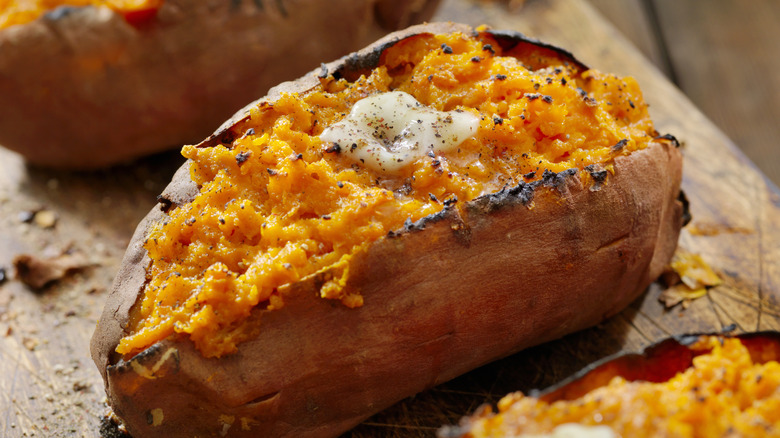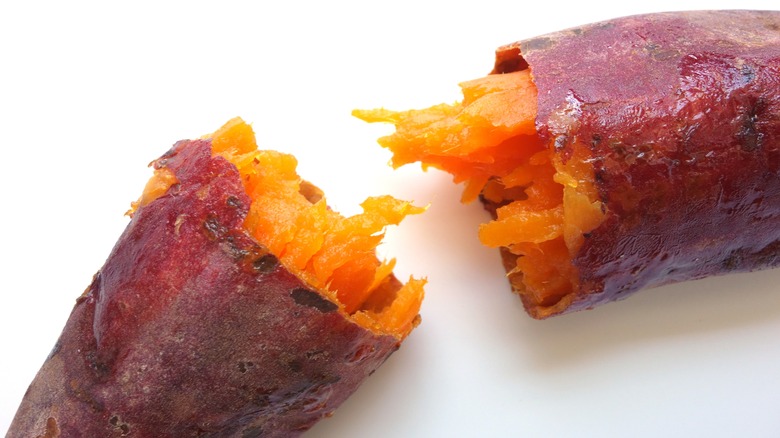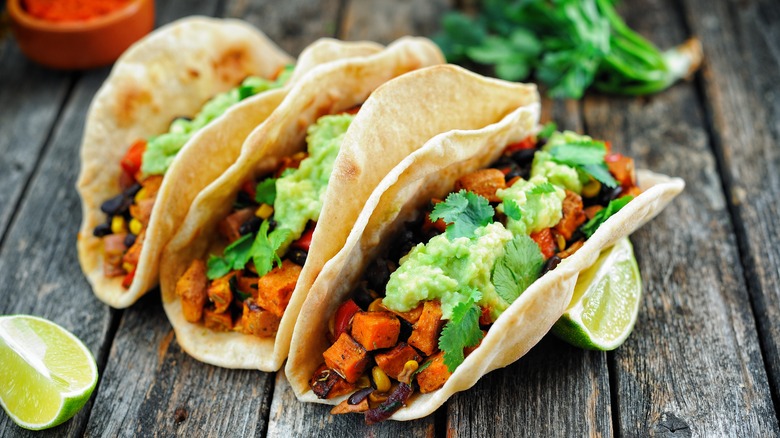Your Freezer Is The Key To Flavorful Baked Sweet Potatoes
Getting the richest, most flavorful baked sweet potatoes starts with a step that seems counterintuitive: freeze them until they're rock solid. If you're skeptical, know this isn't your average home-cook DIY tip; it's an old Chinese street cooking secret for baking sweet potatoes with a caramel-like aroma that draws crowds from a block away. In China, they freeze the sweet potatoes by leaving them outside in frigid winter temperatures. We're all for the rustic way, but if snow isn't in your forecast, your freezer will do fine.
When you freeze sweet potatoes, a couple of cool things happen (pun intended). First, freezing forces out some of the water inside. With less water, the flavor becomes more concentrated, similar to how dried fruit tastes sweeter than fresh fruit. As a result, the sweet potatoes' natural flavors become stronger and sweeter when you bake them.
The second trick is all about temperature. When you bake frozen sweet potatoes, they warm up slowly, which is crucial for developing their sweetness. This slow warming keeps them in the ideal temperature range (135 to 170 degrees Fahrenheit) longer. In this range, enzymes are most effective at breaking down starches into maltose, a sugar that gives sweet potatoes their rich flavor. By freezing sweet potatoes first, you're giving those enzymes the most possible time to work. The result? Sweet, caramel-like baked sweet potatoes that taste like dessert.
The best way to cook frozen sweet potatoes
There are tons of ways to cook frozen sweet potatoes, but one method leaves them the sweetest and fluffiest of them all: slow roasting. Wrap the sweet potatoes in tin foil to trap moisture for even cooking and a soft, tender texture. Do not break the skin, as this helps retain natural sugars and flavors. Ideally, put the sweet potatoes in the oven while they're still cool, so the enzymes have the most time to transform starches to sugar. You can even set the initial cooking temperature lower to prevent the oven from heating up too quickly. Once the sweet potatoes have baked slowly, remove the tin foil and finish on high heat to brown the outside sugars, creating a delicious, slightly crispy exterior while keeping the inside soft and sweet.
How do you know when the sweet potatoes are done? Chef Lucas Sin, who posted a viral frozen sweet potato recipe on Instagram, advises cooking them "until they bleed burnt sugar." For an aromatic flavor boost, add seasonings such as cinnamon, nutmeg, or rosemary. Enjoy your roasted sweet potatoes just like on the streets of China — in a brown paper bag — or on a plate at home.
Mouthwatering ways to serve your perfectly baked sweet potatoes
Now that you've mastered the art of baking frozen sweet potatoes, it's time to get creative with sweet potato recipes. One option is a sweet potato breakfast bowl. Mash up your baked potatoes and serve them in a bowl with a dollop of your favorite yogurt, granola, and a drizzle of honey. Add some fresh berries and nuts for extra crunch and flavor. For a savory twist, make sweet potato tacos by filling warm tortillas with chunks of baked sweet potatoes, black beans, avocado slices, and shredded cheese. Top with a tangy lime crema and chopped cilantro for a tasty and healthy meal.
There are also many great sweet applications for baked sweet potatoes. Turn your baked sweet potatoes into a dessert treat by topping them with a scoop of vanilla ice cream, a sprinkle of cinnamon, and a drizzle of caramel sauce. Add a handful of toasted pecans for a crunch factor. For a classic dessert (or holiday side), try sweet potato casserole with marshmallows: Mash the baked sweet potatoes, mix them with butter and brown sugar, and finish with mini marshmallows before baking until golden. Sweet potato magic awaits!


